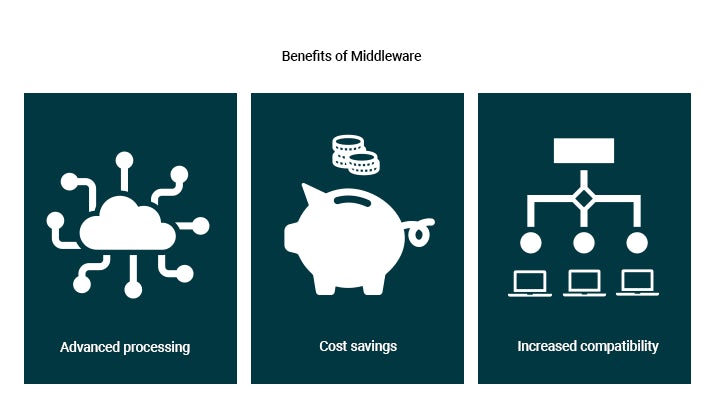What is middleware?

Copywriter

Senior Technical Content Marketing Manager

In this article, you will learn all about middleware and the important role it plays in modern software architecture.
What is middleware?
As the name suggests, middleware is software that sits between the operating system (OS) and applications to assist both in their roles. All processing related to application services and API management is handled by the middleware. The OS, middleware, and applications are computer software programs that work together to run systems on hardware.

Middleware’s history
The term middleware first appeared at the 1968 NATO Software Engineering Conference. Middleware gained popularity in the 1990s with the rise of distributed systems, making system construction using middleware common and widespread.
Advantages of middleware
Here are three benefits of middleware:
- Advanced processing: Applications can run with just the OS, but middleware enables more efficient execution of higher-level processes.

-
Reducing development costs: Middleware consolidates generic functionalities used in applications, allowing for efficient development of application software. By focusing only on specialized business processes, development time and costs can be reduced.
-
Compatibility across a variety of operating systems and hardware: One of the greatest features of middleware is its ability to bridge the gap between between different OS and hardware types. This allows applications to operate consistently across different environments without needing to be directly aware of underlying differences.
Three types of middleware
In a typical web application, there are three layers of middleware:
- Web server middleware
- Application server middleware
- Database middleware
In this three-tier structure, each type of middleware corresponds to one of the three layers of the application: presentation, logic, and data. This structure is widely used in large-scale systems.
Web server middleware
Web server middleware primarily handles the presentation layer of the application by managing HTTP requests and responses, routing traffic, and serving static files. It responds to HTTP requests sent by clients (users), returning responses such as HTML and CSS through web browsers or other client applications.
Application server middleware
Application middleware corresponds to the logic layer and is responsible for executing the business logic of the application. It manages tasks such as authentication, authorization, session management, and request/response processing. This layer orchestrates the application’s core functionality.
Database middleware
Database middleware operates in the data layer, interfacing with the database management system (DBMS). It holds data as a database and performs tasks such as outputting, adding, and deleting data in response to requests.

Together, these three types of middleware form a cohesive architecture that separates concerns and promotes scalability, maintainability, and security in web applications.
The importance of middleware in application development
To build applications, you need an application environment with unified basic functionalities. Middleware plays a crucial role in configuring such an environment, making it indispensable in application development.
Four ways middleware improves application development
Middleware significantly boosts the efficiency and capability of application development through four key functions.
-
DevOps enablement: Middleware facilitates seamless application lifecycle management. It offers DevOps capabilities, including CI/CD, container orchestration, and service mesh functionalities, streamlining the delivery process of application development.
-
Execution environment provisioning: Middleware provides a robust execution environment for deploying custom code. It can offer lightweight runtimes and frameworks for advanced distributed cloud environments like microservices, in-memory caching for fast data access, and messaging for rapid data transfer.
-
Connectivity and integration: Middleware can be used to connect custom applications, commercial applications, and SaaS assets through messaging, integration, and APIs to provide services that make systems function. It can also provide in-memory databases, data caching services, data/event streaming, and API management.
-
Process automation and intelligence: Middleware introduces essential intelligence into the application development process by incorporating optimization, automation, and decision management. This not only streamlines operations but also improves decision-making capabilities within the development lifecycle.
The importance of middleware in system operations
Once an application or system has been developed, middleware also plays a critical role in enhancing and securing the operational performance. It acts as the backbone that supports system reliability, efficiency, and resilience against failures. Here are four ways middleware can enhance the health and performance of system operations:
-
System backup: In the system landscape, data is vital, and in case of server abnormalities or failures, such as customer list loss or disappearance of balance information, the consequences can be immeasurable. Middleware ensures vital data is backed up, safeguarding against loss or corruption, thus facilitating recovery in case of failures.
-
Efficiency in job operations: Job operations refers to routine work like backups, logging, and server. Manual handling of these tasks can become a significant burden. Operational middleware can take care of these tasks, automating jobs through pre-configured processing steps and schedules.
-
System monitoring: System operation involves maintaining the system’s normal state and making changes or expansions as necessary. Detecting system failures promptly is crucial, so operational middleware is used for monitoring tasks like:
-
Node monitoring: Monitors the operational status of servers, storage, network devices, etc.
-
Resource monitoring: Monitors the usage status of memory, CPU, disk, and more.
-
Process monitoring: Monitors if servers are running and services are not stopped.
-
Log monitoring: Monitors for anomalies in logs of the OS and middleware.
-
-
Redundancy with high-availability clusters: Redundancy refers to the ability to maintain the system even in the event of failures by setting up multiple servers with the same functionality. Middleware-based failover mechanisms can seamlessly redirect traffic to backup servers when primary servers fail, helping to prevent system downtime.
The key to development success is CircleCI
CircleCI is a middleware tool that supports the automation of building, testing, and deploying software, maintaining quality and speed across all areas of application development. This ability to enhance cloud-native advantages sets you apart from competitors.
To start experiencing the benefits of seamless automation in your application development and system operations, sign up for a free account today.





